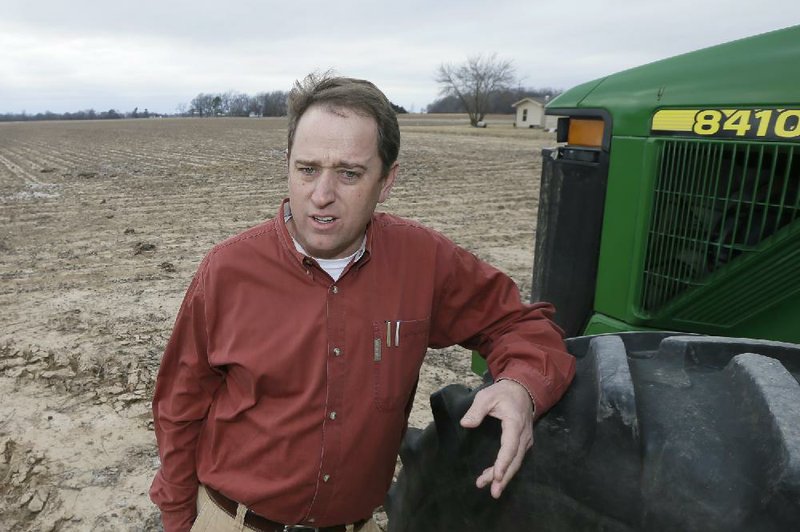MINNEAPOLIS — Farm subsidies that have guided agriculture through record profits in recent years are going away in the five-year farm bill that is up for a Senate vote in the coming week. But farmers aren’t complaining.
Gone are direct payments, a system in which landowners received fixed amounts per acre, whether crop prices were high or low — or even if they didn’t plant at all. Those will be replaced by a choice of one of two different subsidy approaches that require producers to suffer losses before they can get payouts. The bill also contains a new insurance-based program for cotton farmers.
“We loved the old farm bill,” said Woody Anderson, who grows 3,500 acres of cotton in west-central Texas near Colorado City. But farmers knew political support for direct payments was fading, he said.
“We felt like this insurance-type program was innovative. It was reform, if you will, and it was the best we could get in the time that we’re trying to operate in and get a new farm bill,” he said.
The farm bill’s authors tout the changes as reform, particularly the elimination of direct payments, which cost $4.5 billion annually. The legislation also caps how much money an individual farmer can receive — $125,000 annually for all payments and loans. But that maximum is more generous than versions that passed the House and Senate earlier.
“We don’t pay people unless there’s actually a reason, because we’ve got a price loss or a crop loss,” said U.S. Rep. Collin Peterson, D-Minn., who was instrumental in crafting the final package. “Under the direct payments, you got payments whether you needed them or not.”
But most of the savings are redirected into the new insurance-based subsidies — one for losses not covered by crop insurance, another that kicks in if crop prices fall below certain thresholds. There’s also more money to expand traditional crop insurance.
Critics say the bill misses a chance for real change. Rep. Ron Kind, D-Wis., said it “maintains huge taxpayer subsidies that go to a few … very large agribusinesses at the expense of our family farmers around the country.”
The changes come as farm country has enjoyed record profits. Projected net farm income for 2013 was $131 billion, a 15 percent jump over the previous year, the U.S. Agriculture Department said in November. Prices have come down from their highs, however.
One of the new programs, called Agriculture Risk Coverage, will cover farmers’ “shallow losses” — what they lose before their regular crop insurance kicks in. For example, if a producer’s crop insurance carries a 25 percent deductible, but the farm suffers only a 15 percent loss, the program could help cover the gap. The program might kick in sooner than previously thought because some crop prices have dropped in recent months.
The other program, Price Loss Coverage, looks more like the soon-to-end traditional price support programs. Farmers will get payments if crop prices fall below certain targets, such as $3.70 per bushel for corn, $8.40 for soybeans and $5.50 for wheat. The bill would raise the floor price for all 14 crops it covers, almost doubling some, so the subsidies would kick in much sooner than current law if prices drop enough.
Losing direct payments will be hard for Southern rice farmers, said Dow Brantley, who helps run a family farm that grows rice, corn, cotton and soybeans on about 8,500 acres in central Arkansas near England. He said the price-loss coverage won’t offer nearly as much profit protection.
“It’s not going to be the same, but we do have something in place to back us up if the world came apart,” Brantley said. “It’s just not the safety net that we all would hope to have.”
Also buried in more than 900 pages of the new farm bill is a small nationwide program that will allow low-income families to double their food-stamp benefits at farmers markets.
Details of the Food Insecurity Nutrition Incentive program have yet to be hammered out, but proponents say that if it proves as successful as similar state efforts, the USDA’s $100 million program could help hungry families and also address the country’s obesity crisis.
“This program helps families buy healthy food from their local farmers markets, which also helps family farmers and boosts the economy,” said Sen. Debbie Stabenow, D-Mich., chairman of the Senate Agriculture Committee, who was instrumental in introducing the plan.
The program is expected to provide matching funds to farmers markets, up to $20 million annually for five years, to incentivize Supplemental Nutrition Assistance Program recipients to buy more fresh fruits and vegetables with their benefits.
Information for this article was contributed by David Pitt, Mary Clare Jalonick and Steve Karnowski of The Associated Press and by Tim Carman of The Washington Post.
Front Section, Pages 4 on 02/02/2014

